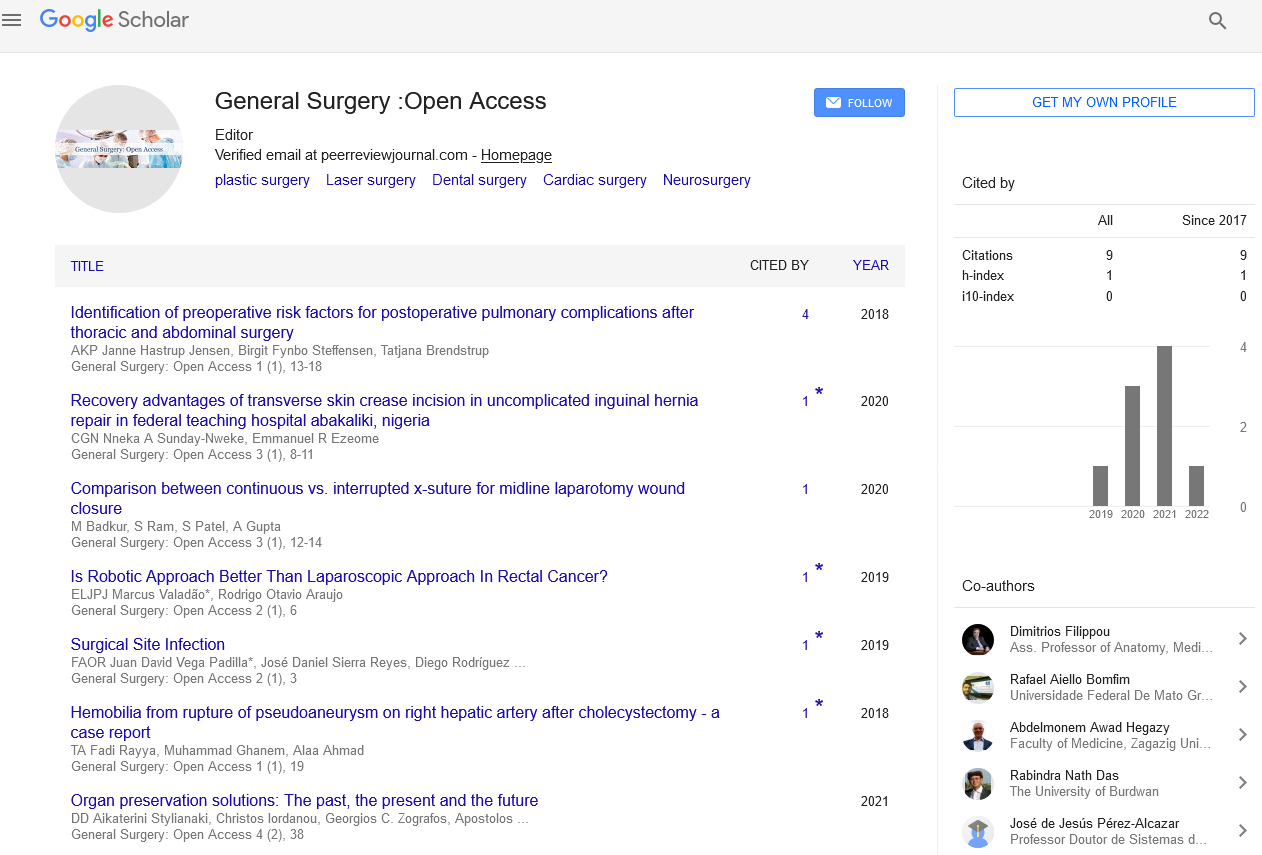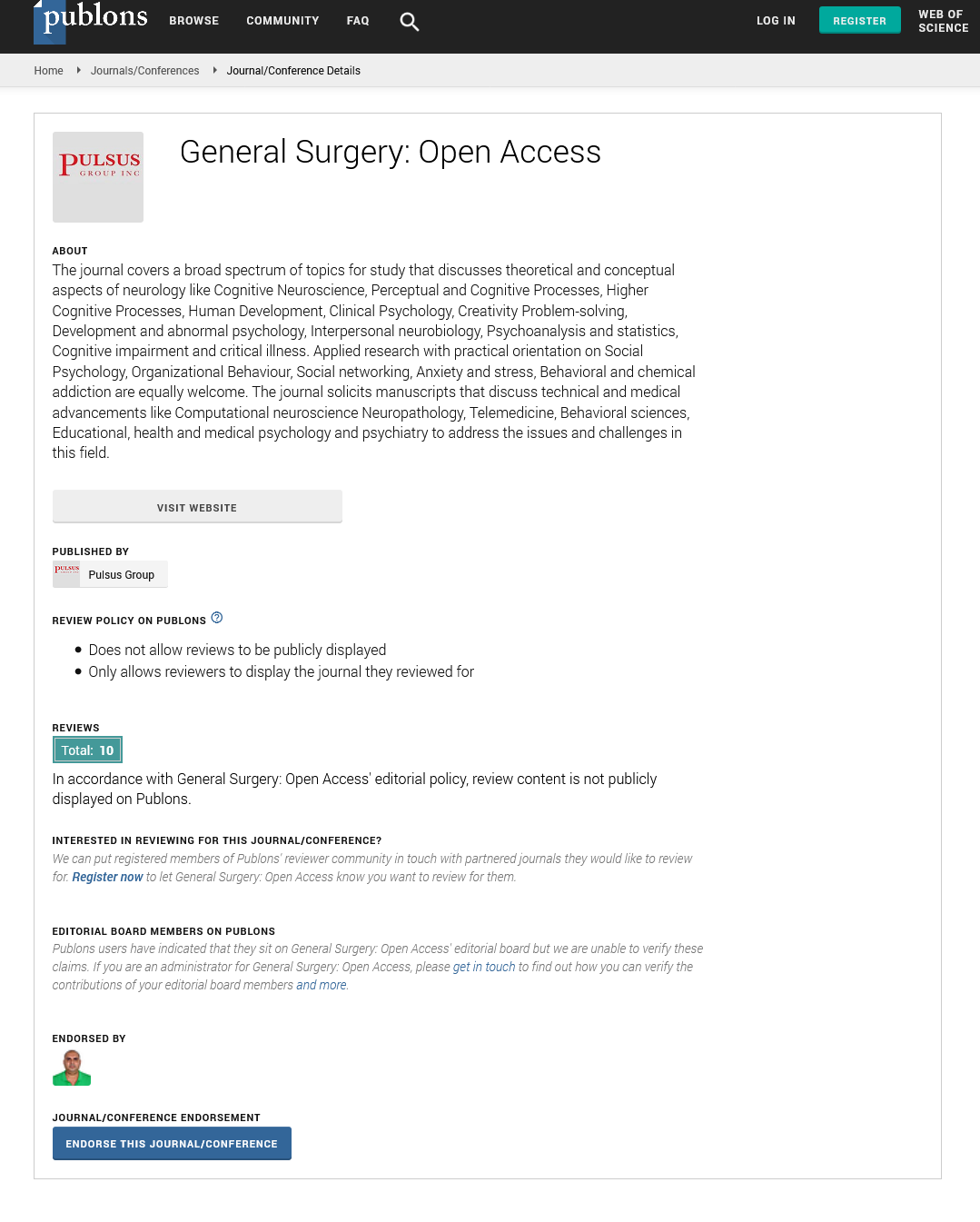Biological Acellular Dermal Matrix (ADM) with inferior anterior dermal sling support in pre-pectoral one stage breast reconstruction with anterior coverage
Received: 03-Aug-2022, Manuscript No. PULGSOA-22-5226; Editor assigned: 05-Aug-2022, Pre QC No. PULGSOA-22-5226; Reviewed: 19-Aug-2022 QC No. PULGSOA-22-5226; Revised: 03-Oct-2022, Manuscript No. PULGSOA-22-5226; Published: 10-Oct-2022
Citation: Smith D. Biological Acellular Dermal Matrix (ADM) with inferior anterior dermal sling support in pre-pectoral one stage breast reconstruction with anterior coverage. General Surgery: Open Access 2022;5(3):1-3.
This open-access article is distributed under the terms of the Creative Commons Attribution Non-Commercial License (CC BY-NC) (http://creativecommons.org/licenses/by-nc/4.0/), which permits reuse, distribution and reproduction of the article, provided that the original work is properly cited and the reuse is restricted to noncommercial purposes. For commercial reuse, contact reprints@pulsus.com
Abstract
Breast reconstruction has improved with the use of implants made of Acellular Dermal Matrix (ADM). ADM is a biotechnologically created human tissue of pig or cow origin in whose cellular antigens are eliminated during tissue processing. We present the one stage prepectoral breast reconstruction using ADM in this case report. Using a prepectoral implant, skin reduction breast reconstruction was completed. The inferior dermal flap was used to generate a combined dermal pocket, which was then used to cover the implant. It was extended till the higher pole and then sutured with a patch of acellular dermal matrix. This method allows single stage rapid repair with a greater reliance on vascularized tissue and implant support and less need on ADM. Additionally, there is less anatomical disturbance and postoperative discomfort in the pre-pectoral region.
Keywords
Acellular dermal matrix; Prepectoral breast reconstruction; ADM; Implant; Inverted-T mastectomy; Skin reducing mastectomy; Immediate implant reconstruction; One stage breast reconstruction
Introduction
One of the most prevalent malignancies, with a rising prevalence in the female population, is breast cancer. This statistics may be influenced by advances in early detection and contemporary primary preventive strategies. Breast reconstruction and the choices for it are standard of care in combination with breast cancer therapy. Depending on the indication, there are several approaches for breast reconstruction, such as autologous tissue reconstruction, implant based reconstruction, or a combination of techniques [1].
The most popular kind of reconstruction is implant based breast reconstruction. Implant-based reconstructive procedures have improved, which has increased demand and aesthetic satisfaction. Over time, these fresh methods have been put forth, spawning a brand-new surgical specialty termed "oncoplasty". Additionally, patients want reconstructive treatments to be performed with fewer stages, less anatomical disturbance, and greater patient comfort. Direct to implant reconstruction and pre-pectoral reconstruction are becoming common practises.
Acellular Dermal Matrix (ADM) implants have improved plastic surgery procedures for breast reconstruction and other procedures. There have already been descriptions of ADM use in prepectoral breast reconstruction. Caputo et al. published the first description of skin reduction breast reconstructions using a prepectoral implant in 2016. The inferior dermal flap was used to produce a combined dermal pocket, which was used to conceal the anatomical implant. It was extended till the higher pole and sutured with a patch of ADM [2].
Discussion
We described a case of an inverted T mastectomy with rapid one stage breast reconstruction employing an ADM on the upper pole and a dermal vascularized sling support for the inferior pole made from the inframammary fold beneath the equator of the breast, sutured with the inferior border of the ADM. In an inverted-T skin reduction mastectomy using the Wise pattern, this procedure enables the creation of a breast pocket in the subcutaneous region above the pectoralis major muscle.
Caputo et al. first introduced the method in 2016. The similar method was used for prepectoral, two stage breast reconstruction with wise pattern skin reduction for patients with high BMI later in 2019 according to Thuman [3].
This method allows a single stage rapid repair with a greater utilization of vascularized tissue, less ADM, and implant support. Additionally, there is less anatomical disturbance and postoperative discomfort in the pre-pectoral region.
As the idea of breast reconstruction has evolved over time, it is now preferred to be able to undergo an Instant Breast Reconstruction (IBR) BR in order to minimize the number of operations and associated costs to the healthcare system. The other hand on the other side, IBR with implants may result in skin stretching that might induce skin flap necrosis, particularly at the T-junction IBR and delayed breast reconstruction both have post-operative problems, as several publications have demonstrated. Sub muscular and pre-pectoral IBR were seen from a fresh angle as a result of the usage of ADM to cover the breast implant. The use of ADM in the sub muscular IBR enables better lateral control of the breast implant without the activation of the serratus muscle and/or reduced coverage in the dual plane reconstruction with long lasting aesthetic benefits [4,5].
Before the development of ADMs, the implant's muscle covering was essential. ADM is essential in the pre-pectoral IBR because it prevents the pectoralis major from being overused, which lowers the chance of upper migration ion is typically advised for patients who have implants that are less than 500 cc, though some authors have described pre-breast reconstruction with implants that are more than 600 cc. Due to the risk of creating a "contrived breast" with sub muscular implant implantation, many surgeons opt for pre-pectoral breast reconstruction. This feature is significant and connected to a decline in muscular function. Bindingnavele et al. published the first description of ADM's application in pre-pectoral implant based reconstruction in 2007.
Conclusion
With the use of the wise pattern skin reduction in a pre-morbid ptotic breast, we were able to provide our patient a single stage reconstruction with enhanced form. The pre-pectoral space caused less disturbance to her anatomy, resulting in increased post-operative comfort for the pectoralis major and serratus anterior muscles. The dermal support flap had two functions: It provided vascular support for the skin that covered the Wise pattern T-junction and mechanical support for the implant's weight. Additionally, the use of autologous tissue resulted in a reduction in the quantity of ADM needed, which also reduced the cost. This procedure can be viewed as a safe way to enhance outcomes and reconstructive options for a bigger, ptotic breast.
References
- Sisti A, Huayllani MT, Boczar D, et al. Breast cancer in women: A descriptive analysis of the national cancer database. Acta Bio Med. 2020;9:332-41.[Crossref] [Googlescholar][Indexed]
- Sadeghi P, Aryan N, Sisti A. Recent advances in implant-based breast reconstruction. Plast Reconstr Surg. 2021;147:875-6.
- Karadeniz Cakmak G. Innovative standards in oncoplastic breast conserving surgery: From radical mastectomy to extreme oncoplasty. Breast Care. 2021;16:559-73. [Crossref] [Googleschooar] [Indexed]
- a PS, Billon R, Schonauer F, et al. Skin-reducing oncoplasty: A new concept and classification in breast cancer surgery. Ann Chir Plast Esthet. 2018;63:285-93. [Crossref] [Googleschooar] [Indexed]
- Zucca-Matthes G. Oncoplastic breast surgery techniques for the general surgeon. Springer Cham, 2020, pp. 613-23.






